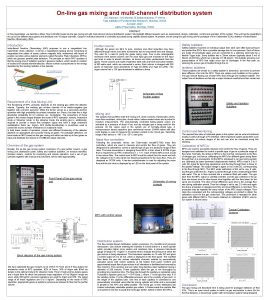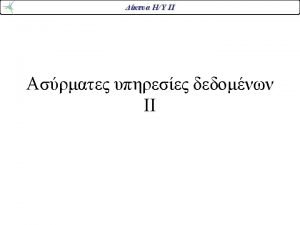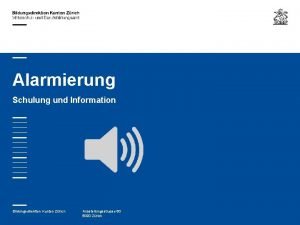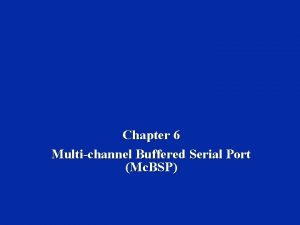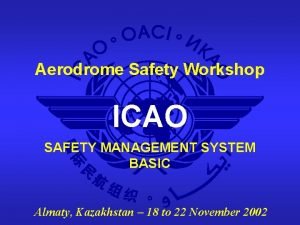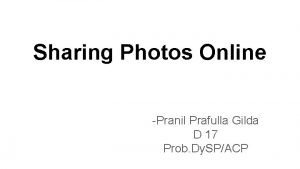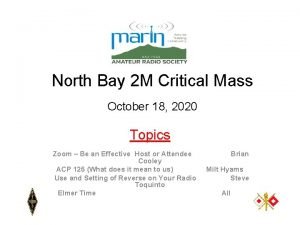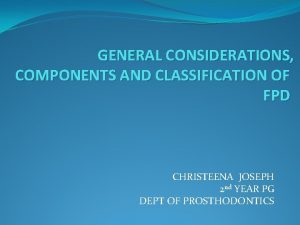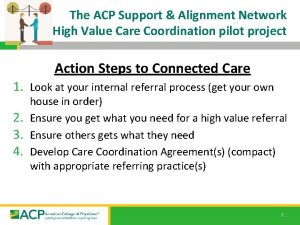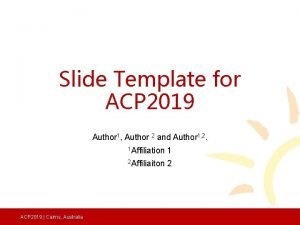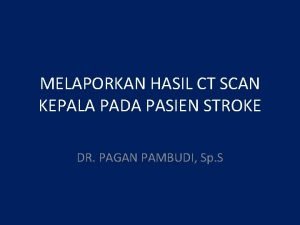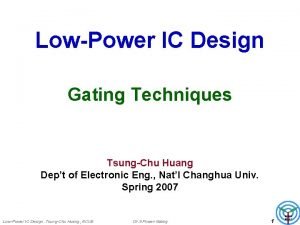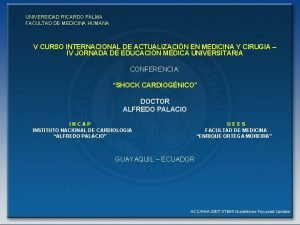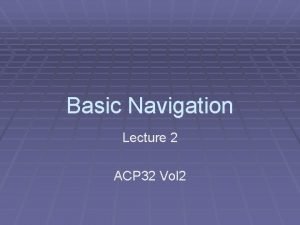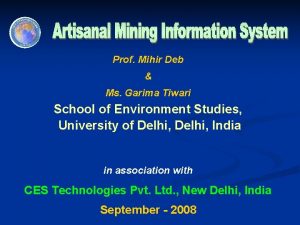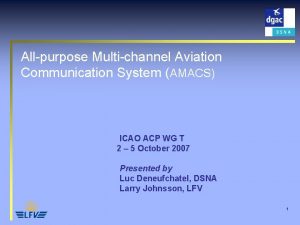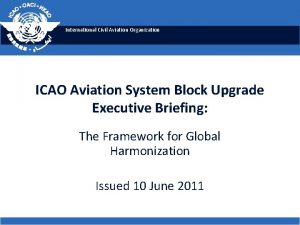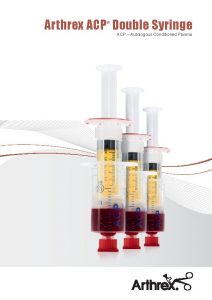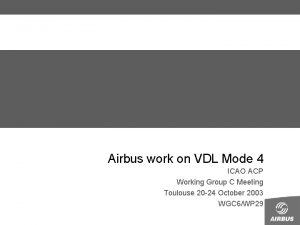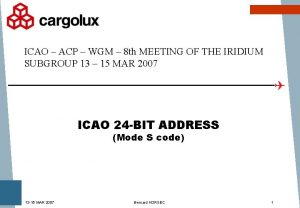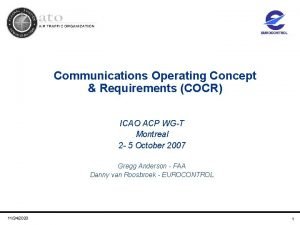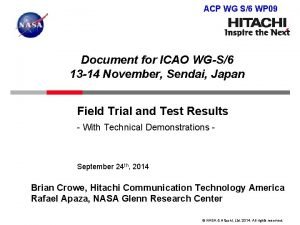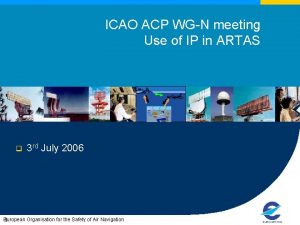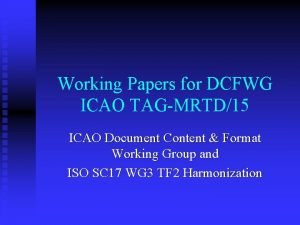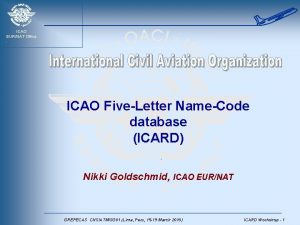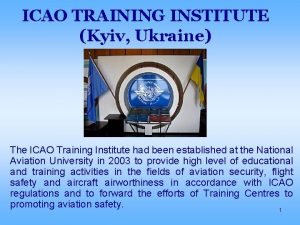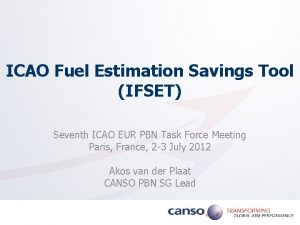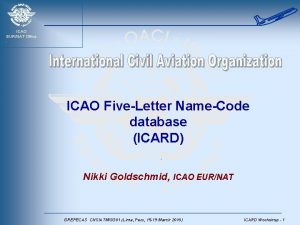Allpurpose Multichannel Aviation Communication System AMACS ICAO ACP






































- Slides: 38

All-purpose Multi-channel Aviation Communication System (AMACS) ICAO ACP WG T 2 – 5 October 2007 Presented by Luc Deneufchatel, DSNA Larry Johnsson, LFV 1

Introduction l Future Communication Study l l l Emerging understanding l l l E-TDMA proposed by DSNA XDL 4 proposed by LFV Spectrum availability and RF environment will dictate our options Plug in of generic systems (COTS) in aviation environment is difficult and challenging AMACS l l l Based on: E-TDMA + XDL 4 + experience from other aviation systems + COTS elements Constraint driven development approach One multichannel narrowband alternative in L-band 2

AMACS system overview l l Flexible multipurpose communication system Cellular narrowband (100 -400 k. Hz) point-to-point system intended to operate primarily within the 960 -975 MHz frequency allocation designed for flexible deployment l l l Supports different channel bandwidths and bit rates to cope with various operational needs (high and medium density airspace) Robust physical layer based on GSM/UAT modulation types associated with strong data coding Efficient handling of Qo. S with guaranteed transmission delay (based on the TDMA structured MAC layer) Support of unicast and multicast data communications taking advantage of VDL Mode 4 broadcast experience Support of air-air point-to-point data communications 3

AMACS performance objectives l l A flexible and scalable solution providing for operational expansion A configurable channel size to match the foreseen traffic densities of Europe in 2020+ l l An adapted performance for the different Qo. S classes l l l Frequency plan needed to allocate the available spectrum to the various types of channels (bandwidth and type of service) Frame structure identifies distinct time slots at MAC layer Specific and reserved channel resources for high Qo. S transmissions Strong robustness at physical layer level to ensure: l l l Achievement of the highest Qo. S in terms of latency Predictive behaviour in a typical distorted propagation channel Co-site operation on board aircraft by minimizing susceptibility level 4

AMACS key facts 1 l Key design drivers l l E-TDMA and XDL 4 concepts have been merged l l l Providing an adapted technical solution to data-link communications needs of 2020+ EMC “constraint driven” development Based on proven concepts l l Robustness, flexibility, scalability Robust proven GSM physical layer High performance E-TDMA MAC layer VDL Mode 4 broadcast protocols Designed to handle up to 175 aircraft per cell in highdensity airspace l l Efficient air-initiated cell handover mechanism Uses aircraft knowledge of cell locations and characteristics either EFB loading or CSC channel) (through 5

AMACS key facts 2 l Initial deployment in the lower L-band to support: l l l New ATM point-to-point services requiring high Qo. S (support to SESAR or NEXTGEN future concept) Broadcast services provided in segregated channel if spectrum availability in the lower L-band is sufficient Air-air data communication provided in segregated channels AOC data communications achievable if extra spectrum is available for dedicated channels Could be transposed to the VHF band in the long term when it becomes available for new technology l More capacity offered to cover all the needs above 6

AMACS key facts 3 l Airborne co-site interference in the lower L-band is addressed by using: l A common synchronization bus between L-band systems to protect other L-band systems from AMACS transmissions l l Other systems are notified of any transmission from AMACS to take the appropriate measure A strong coding of the channel to provide high robustness for airborne reception l l l The ratio between the shortest bit duration in a slot and the duration of the spurious burst is approximately 0· 5 to 1 This leads to potential interference windows covering no more than two or three consecutive bits These can be recovered by the various coding mechanisms 7

AMACS Presentation l This presentation focuses on an air/ground point-topoint channel supporting the highest bit-rate per cell l Minimal configurations can be tailored for the periphery of Western Europe l l 400 k. Hz/520 kbps Foreseen for the en-route high-density area of Western Europe 100 k. Hz/130 kbps Intermediate configurations can be tailored for major TMA areas l 200 k. Hz/ 260 kbps 8

Typical high bit-rate point to point instantiation of the AMACS system 9

Lower layers characteristics 1/2 l Design goals l l l Low Bit Error Rate at low Signal-to-Noise ratio Occupation of least possible bandwidth Good performance in multipath and fading environments Introduce least amount of residual power in the RF environment Simple and cost effective to implement MAC considerations l 148 octets afforded per slot for data to meet the most critical services defined in the COCR 10

Lower layers 2/2 l Narrowband system based on GSM physical layer l l l l Modulation based using Gaussian Minimum Shift Keying (GMSK) Pre-filtering leads to compact waveform (minimal sidelobes) 400 k. Hz channels Gross Bit rate of 520 kbps C/I of 9 d. B (including FEC) May allow reuse of some GSM hardware components Error Correction Outer code RS coding l l Inner code Interleaving Convolutive coding Concatenated coding Inner code – Convolutional code with puncturing Interleaver – Block and diagonal interleaving Outer code – Reed-Solomon 11

Why GMSK modulation rather than CPFSK or GFSK ? l GMSK is a modulation known and tried with GSM l The global deployment of GSM implies cheap costs of development for equipment l A cellular system and a waveform adapted to frequency re-use radio networking (C/Icc=9 d. B and C/Iadj=-9 d. B) l Allows the best compromise between BER and bit-rate 12

Link budget l Hypothesis: l l l Free space propagation Frequency : f =975 MHz Propagation distance: d=150 NM =278 Km Antennas Gains: Ge= -3 d. B Gr= 0 d. B Reception power: Pr=-100 d. Bm (to ensure BER=10 -3 on a 400 k. Hz channel) The pathloss is computed by the following formula: 13

Error correcting scheme Convolutive decoding De-Interleaving RS decoding Interleaving does not affect the BER but improves the distribution of errors Convolutive code are used to remove isolated error RS code has the effect of removing burst of errors 14

Error correcting scheme l The code rate - The convolutive code is the well known punctured (133, 171), constraint length 7. So only three rates are practical: - The RS code is the RS(31, x; 5) So only two rates are practical, with t=[1; 2] 15

Error correcting scheme l Four configurations are suitable: 1) 2) 3) 4) 16

Error correcting scheme l BER in convolutional code l With a convolutional code (5, 7) a BER=10 -3 at the input gives a BER=10 -5 at the output. In order to mitigate the puncturing, the BER at the output will be considered equal to 10 -4. l l BER in RS code: With a the BER at the output of the RS code (31, 27, 5), is arround 10 -7, so the conditions are met for two of the configurations 17

Other solution l Using only the RS coder De-Interleaving RS decoding With a RS coder (31; 25), the code rate will be: And the BER : This solution seems relevant but must be modelled and simulated over an appropriate representative radio channel 18

Basic slot characteristics l TDMA access scheme with 4 millisecond slots l l Ramp-up/down times total < 0· 1 ms Guard time allowance of 0· 9 ms, allows a GS range of 150 NM Usable slot duration 3 ms Time synchronization to UTC will be required l Time information uplinked by the ground station for aircraft use individual slot structure In bits FEC, CRC In bits total slot duration 4 ms Guard time depending on cell size In bits signalling and data decay Ramp-up Synch next slot 19

MAC layer organization l For point-to-point channels, AMACS will use the MAC layer principles developed for E-TDMA l Channel will have a frame repeating every 2 seconds l Uplink sections - use is configurable (dynamically) by the ground station (GS) l l Ground reserved area for uplinks and ground-directed signalling Downlink sections - divided into sub-sections for different Classes Of Service (COS) l l Each A/C has one exclusive slot for high Qo. S messages More downlink slots are available on request 20

Downlink Classes Of Service (COS) l COS 1 l l High Qo. S Service Dedicated section of the frame for high-priority short messages from aircraft Each aircraft within range of the ground station is allocated its own slot in which it may transmit in every frame (thus every 2 seconds) COS 2 l l l Lower Qo. S Service A section of the frame for lower priority and/or longer messages from aircraft Section also allows for re-sends in the same frame 21

Frame structure – point-to-point Frame Start of UTC second UP 1 Co. S 1 UP 2 Cell insertion Framing message Reserved slots for Exclusive primary Second uplink messages slots for short, high for ACKs, CTS, Qo. S messages or reservations RTS messages Uplink section Downlink section Co. S 2 Uplink section Shared slots, reserved or random access: used for any messages Shared section 22

Uplink & Cell Insertion Frame Sections l UP 1 l l l UP 2 l l l 1 st Uplink Section for ground station use For data uplink and ACKs of received data 2 nd Uplink Section for ground station use For CTS/ACK ALL messages For reservation messages reserving space in COS 2 For framing message Cell Insertion l Dedicated section for new aircraft to logon to the ground station when it comes within range 23

Flexible frame structure l l The flexibility to cope with different numbers of aircraft and traffic demand is built into the frame structure Lengths of each section of the frame (COS 1, COS 2, UP 1, UP 2) can be varied by the ground station l l l In particular the length of the COS 1 section follows the number of logged-on aircraft very closely Details of the current frame structure and of the frame structure in x frame’s time will be broadcast every frame in a Framing Message The framing message will also broadcast the length of the Cell Insertion section 24

MAC layer characteristics l Frame length of 2 seconds l l l Divided into 500 slots of length 4 ms It is assumed that this size is fixed globally Slot characteristics l l l l Active slot length: 4 ms – (ramp + guard times) Bits per slot: Active slot length × Bit rate Bits for CRC/FEC: ~30% of bits per slot octets) Remainder: Bits per slot – CRC = 1244 bits ISO flags + reservation header Addresses plus administrative flags (average) User data space = 3 ms = 1, 620 bits = 376 bits (47 = 155· 5 octets = 3 octets = 4· 5 octets = 148 octets 25

Slot structure n Ramp-up 1 octet ISO Flag Addresses plus flags 4· 5 octets (typical) 148 octets User data 4 ms Reservation header FEC / CRC 3 octets (if required) 47 octets ISO Flag 1 octet Guard time 0· 9 ms Ramp-down m NOTE: n + m < 0· 1 ms 26

Cellular deployment l l Worst case (air-air interference) l l l l 12 frequency re-use pattern Carrier/Interferer (C/I) calculation dw = R and di = 4 R, for cell radius R C/I = Att (interference) – Att (wanted) Propagation model: l Att = (constant) + a. 10 log(d) a = 2 (Free space) or more C/I = a. 6 d. B, Thus C/I ≥ 12 d. B But for GMSK, 9 d. B is enough, with GSM FEC rate 260/456 (0. 57 ratio), and a very light interleaving 27

AMACS Network Architecture l l AMACS infrastructure comprises a number of AMACS Ground Stations which are organized into clusters Each Ground Station in a cluster will be connected to some concentrator, the Ground Network Interface (GNI) ATN A/G Routers and the IPv 6 Routers are ground-based users of the AMACS subnetwork service and the airborne ATN and IP routers are mobile users of the AMACS sub-network service 28

Airborne Architecture l Avionics for AMACS implementation of ATS, AOC and ADS-B functions 29

System operations - Entry l Aircraft entry l Section at the beginning of Co. S 2 dedicated to cell insertion l l l A/C will already know the GS frequency A/C will listen for 2 seconds to hear the “framing” message This will tell it the GS ICAO address and the cell frame structure A/C will then transmit cell insertion message in the dedicated slots This contains the A/C ICAO address and the GS ICAO address GS will reply in UP 1 l l Containing GS ICAO address, A/C ICAO address, new local 9 -bit A/C address, GS 7 -bit local address, allocated slot number Local addresses are used to avoid ICAO 27 -bit addresses occupying large amounts of space in transmissions 30

System operations - Uplink l The GS will transmit data to the A/C in UP 1 l If correctly received – l l If not correctly received – l l The A/C will send a NACK as part of its Co. S 1 transmission GS will re-send data in UP 2, with an ACK slot reserved in Co. S 2 A/C will send an ACK or NACK) in the allocated Co. S 2 slot GS transmits framing message at start of UP 2, containing – l l l Each A/C will send an ACK as part of its Co. S 1 transmission The ground station’s full ICAO address UTC time, Frame section sizes UP 2 is also used for transmitting the combined ACK/CTS message to all aircraft 31

System operations - Downlink l Each A/C has an allocated Co. S 1 slot for downlink l l If Co. S 1 transmission is correctly received – l l Regular transmission of short data messages If the data size is too large, an RTS is transmitted in Co. S 1 (This is a request for a longer Co. S 2 slot) When an A/C has no data, it transmits a keep-alive message The GS responds in the combined ACK/CTS message in UP 2 If not correctly received – l l The A/C will re-transmit in Co. S 2, using random access The GS can reply with a dedicated ACK in Co. S 2 32

System operations – Hand-off l Hand-off procedures l l l A/C will know the locations of ground stations When nearing the edge of a cell, A/C will contact the next GS The A/C will indicate to current GS that it’s exiting the cell l If this process completes correctly handover will be quick (1 slot) Otherwise the link will time-out GS will de-allocate Co. S 1 slot after a correct hand-off l l If contact is broken before hand-off process is complete, the A/C’s Co. S 1 slot will remain reserved for a pre-set period This will prevent a disruption of communications caused by premature slot re-allocation after a short-term signal loss 33

Broadcast channel l Superframe characteristics l l l Same MAC structure as VDL Mode 4 l l 15, 000 slots in one 60 s superframe 4 ms slot length Random access using the VDL Mode 4 reservation protocols Dedicated ground-reserved block at start of each superframe Increased basic message size, more convenient for ADS-B Most VDL Mode 4 broadcast protocols will be used l l Modified for single channel and AMACS frame structure No point-to-point transmissions permitted 34

Point-to-point channel Defined AMACS messages l l Binary codes for AMACS message types: 6 bits 00 0000 is not used Message type Binary code Co. S 1 Downlink 00 0001 Uplink 00 1000 Co. S 1 Keep-alive 00 0010 Block reservation 00 1001 Co. S 2 Downlink 00 0011 Framing message 00 1010 Co. S 2 RA short 00 0100 CTS 00 1011 Co. S 2 RA long 00 0101 ACK 00 1100 Co. S 2 RA RTS 00 0110 ACK/CTS ALL 00 1101 Cell exit 00 0111 Cell insertion 00 1110 Message type Binary code 35

Example Message structure Cell insertion CELL_INS message type A/C Tx 109 bits ISO flag 8 Binary 0111 1110 Version number 2 Binary 00 Address length flag 1 Binary 0 for local addresses Binary 1 for 27 -bit ICAO addresses A/C ICAO address 27 Message type 6 Binary 00 1110 Message identifier 6 1 to 64 (00 0001 to 11 1111) GS ICAO address 27 Destination ground station Authentication (32) Size not fixed A/C will listen for framing message to identify the cell insertion slots GS reply to cell insertion message will be transmitted in the next UP 1 36

AMACS summary l l l l Flexible multipurpose L-band communication system Cellular, narrowband system Channel bandwidths (100 - 400 k. Hz bandwidth) and bit rates adaptable according to operational needs Robust physical layer based on GSM/UAT modulation types Efficient handling of Qo. S with guaranteed transmission delay Support of air-ground point-to-point data communications and air-air, using multiple channels Support of multicast/broadcast data communications taking advantage of experience of existing systems 37

AMACS Status l The high level design of AMACS is now finalised l l l l l At Physical and MAC layer levels Complete definitions of frame, slot, and message structures Error correction coding definition completed Initial channel structure, cellular deployment and network architecture specified All MAC message types defined Definition of services provided Protocols and system operation defined for both point-topoint and broadcast communication On going activities at DSNA regarding the airborne co-site compatibility (DME and Mode S) including laboratory test with GA DME Further activities to refine the design and assess more accurately the performances are necessary 38
 Gat
Gat What is a multichannel distribution system
What is a multichannel distribution system Single channel data acquisition system
Single channel data acquisition system Multichannel multipoint distribution service
Multichannel multipoint distribution service Ausstellungsstrasse 80
Ausstellungsstrasse 80 Multichannel publishing
Multichannel publishing Multichannel fundraising
Multichannel fundraising Multichannel publishing cms
Multichannel publishing cms Multi channel retailing definition
Multi channel retailing definition Disadvantages of multi channel retailing
Disadvantages of multi channel retailing Bufferedserial
Bufferedserial Pengertian multi channel
Pengertian multi channel Multichannel publishing
Multichannel publishing Licence
Licence Multichannel retailing ppt
Multichannel retailing ppt Aerodrome safety management
Aerodrome safety management Rcem acp
Rcem acp Dysp pranil gilda age
Dysp pranil gilda age Acp leadernet
Acp leadernet Acp 125 g
Acp 125 g Indications for fpd
Indications for fpd Class 3 mod 1
Class 3 mod 1 Palmitoil acp
Palmitoil acp Acp in finance
Acp in finance Acp high value care
Acp high value care 2019/?author=1
2019/?author=1 Acp data mining
Acp data mining Hasil ct scan edema serebri
Hasil ct scan edema serebri Set_clock_gating_style
Set_clock_gating_style Acp high value care curriculum
Acp high value care curriculum Universidad ricardo palma medicina
Universidad ricardo palma medicina Acp classification of fpd
Acp classification of fpd Acp 32
Acp 32 Ačp
Ačp Acp journal wise
Acp journal wise Acp programme
Acp programme Acp programme
Acp programme Acp programme
Acp programme Garima tiwari model
Garima tiwari model

